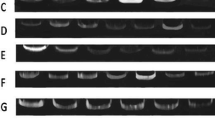Abstract
The substitution of ewe’s and goat’s milk for cheaper cow’s milk is still a fraudulent practice in the dairy industry. Moreover, soy-based products (e.g., soy milk, yoghurt) have to be checked for cow’s milk as they are an alternative for people suffering from an allergy against bovine milk proteins. This work reports the evaluation of different protein-based electrophoretic methods and DNA-based techniques for the qualitative detection as well as the quantitative determination of cow’s milk percentage in dairy and soy milk products. Isoelectric focusing (IEF) of γ-caseins using an optimized pH gradient was appropriate not only for the detection of cow’s milk, but also for an estimation of cow’s milk percentage in mixed-milk cheese varieties. Urea-polyacrylamide gel electrophoresis (PAGE) proved the method of choice to detect cow’s milk in soy milk products, whereas IEF and SDS-PAGE of proteins were not applicable due to false-positive results. Polymerase chain reaction (PCR) analysis was used to confirm the results of protein-based electrophoretic methods. Problems inherent in quantitative analysis of cow’s milk percentage using protein-based techniques and even more using DNA-based methods were emphasized. Applicability of quantitative real-time PCR for the determination of cow’s milk percentage in mixed-milk cheese was shown to be hampered by several factors (e.g., somatic cell count of milk; technological parameters influencing the final DNA concentration in ripened commercial cheese samples). The implementation of certified reference standards (of major relevant cheese groups) containing 50% cow’s milk was urgently recommended to enable at least a yes/no decision in commercial mixed-milk cheese samples.

Austrian cheese variety manufactured from cow’s, sheep’s and goat’s milk






Similar content being viewed by others
References
Mayer HK, Heidler D, Rockenbauer C (1997) Int Dairy J 7:619–628
Borková M, Snášelová J (2005) Czech J Food Sci 23:41–50
Mills ENC, Breiteneder H (2005) Biotechnol Adv 23:409–414
Cederroth CR, Nef S (2009) Mol Cell Endocrinol 304:30–42
Caffarelli C, Baldi F, Bendandi B, Calzone L, Marani M, Pasquinelli P (2010) Ital J Pediatr 36:5
Poms RE, Klein CL, Anklam E (2004) Food Addit Contam 21:1–31
Monaci L, Tregoat V, van Hengel AJ, Anklam E (2006) Eur Food Res Technol 223:149–179
Haug A, Høstmark AT, Harstad OM (2007) Lipids Health Dis 6:25
Van Hengel AJ (2007) Anal Bioanal Chem 389:111–118
Commission Directive (2007) Amending Annex IIIa to Directive 2000/13/EC of the European Parliament and of the Council as regards certain food ingredients. EC No 68/2007 of 27 November. Off J Eur Commun L310:11–14
Ramos M, Juarez M (1986) Chromatographic, electrophoretic and immunological methods for detecting mixtures of milks from different species. Document 202. International Dairy Federation, Brussels, pp 175–187
Mayer HK (2005) Int Dairy J 15:595–604
Hurley IP, Coleman RC, Ireland HE, Williams JHH (2006) Int Dairy J 16:805–812
López-Calleja IM, González I, Fajardo V, Hernández PE, García T, Martín R (2007) Int Dairy J 17:87–93
Addeo F, Pizzano R, Nicolai MA, Caira S, Chianese L (2009) J Agric Food Chem 57:10063–10066
Bottero MT, Dalmasso A (2011) Vet J 190:34–38
Czerwenka C, Müller L, Lindner W (2010) Food Chem 122:901–908
Guarino C, Fuselli F, La Mantia A, Lucia L, Fabbri A, Marianella RM (2010) Rapid Commun Mass Sp 24:705–713
López-Calleja I, González I, Fajardo V, Martín I, Hernández PE, García T, Martín R (2007) Int Dairy J 17:729–736
Lopparelli RM, Cardazzo B, Balzan S, Giaccone V, Novelli E (2007) J Agric Food Chem 55:3429–3434
Zhang CL, Fowler MR, Scott NW, Lawson G, Slater A (2007) Food Control 18:1149–1158
Dalmasso A, Civera T, La Neve F, Bottero MT (2011) Food Chem 124:362–366
Commission Regulation (2008) Reference method for the detection of cows’ milk and caseinate in cheeses from ewes’ milk, goats’ milk and buffalos’ milk or mixtures of ewes’, goats’ and buffalos’ milk. EC No 273/2008 of 5 March 2008. Off J Eur Commun L88:53–61
Suhaj M, Stankovská M, Kolek E (2010) J Food Nutr Res 49:45–52
Mayer HK, Rockenbauer C, Mlcak H (1998) Lait 78:425–438
Bottero MT, Civera T, Nucera D, Rosati S, Sacchi P, Turi RM (2003) Int Dairy J 13:277–282
Schukken YH, Wilson DJ, Welcome F, Garrison-Tikofsky L, Gonzalez RN (2003) Vet Res 34:579–596
Sharma N, Singh NK, Bhadwal MS (2011) Asian-Aust J Anim Sci 24:429–438
Fox PF (2004) Cheese: Chemistry, physics and microbiology, 3rd edn. Chapman & Hall, London
Bustin SA (2004) A-Z of quantitative PCR. International University Line, La Jolla
Acknowledgements
Model cheeses were kindly provided by the Federal Research Station of Dairy Science, Wolfpassing, Austria. Thanks are also due to Bohus Kaliarik (Trade manager, Bryndziaren a syraren, s.r.o., SNP 5, 962 01, Zvolenska Slatina) for supplying Slovakian Bryndza model cheeses.
Author information
Authors and Affiliations
Corresponding author
Additional information
Published in the special paper collection Recent Advances in Food Analysis with guest editors J. Hajslova, R. Krska, M. Nielen.
Rights and permissions
About this article
Cite this article
Mayer, H.K., Bürger, J. & Kaar, N. Quantification of cow’s milk percentage in dairy products – a myth?. Anal Bioanal Chem 403, 3031–3040 (2012). https://doi.org/10.1007/s00216-012-5805-1
Received:
Revised:
Accepted:
Published:
Issue Date:
DOI: https://doi.org/10.1007/s00216-012-5805-1




